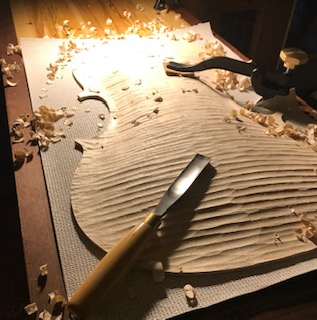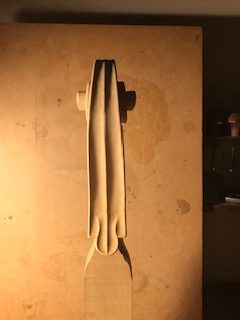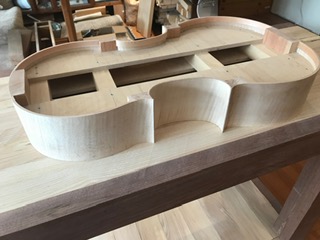About five years ago, my daughter heard an instrument made by the Canadian luthier Mark Schnurr. (A luthier is someone who makes or repairs string instruments.) She was so impressed that she visited Mark and purchased one of his violins. At that time, I had a very preliminary discussion with Mark about his cellos. He mentioned that he had some nice wood that he was reserving for a cello.
I wasn’t ready to commission a cello back then, but it kept nagging at me. I already had two cellos that I played with the Symphony. My main instrument is a 1798 Johannes Cuypers, which I adore. About ten years ago I bought a second cello with the intent of using it for outdoor concerts in the summer. It’s a nice instrument, but it’s on the larger side, and I never really became comfortable with it. I would often play my Cuypers outdoors just because I enjoyed it more. All the time, I knew that exposing my old cello to the elements wasn’t good for it, so I started saving my Social Security payments. My intention was to replace my summer cello with something I liked well enough that my Cuypers wouldn’t have to do outdoor duty anymore. If someday that new cello could replace my Cuypers, that would be an added bonus.
In January 2021 I called Mark and asked whether he had made a cello since we’d spoken. He hadn’t, which meant that he still had the wood he was reserving for a cello. We began a months-long conversation about all aspects of what we would both want in a collaboration. That included the physical shape of the cello (what we call the “model” of the cello) and our ideas about sound (for example, which cellos’ and cellists’ sounds we admired). Our discussions convinced us that we would make a good partnership. Mark was familiar with a Domenico Montagnana cello similar in size to my Cuypers and thought that it would be a good match for me. I commissioned him to make a cello modeled after that Montagnana in August 2021.
Of course, it takes a lot of faith in a luthier to take that step, as one doesn’t know in advance exactly what will be produced. From our discussions, I knew the cello’s shape and size and that Mark would do everything in his power to create something we were both happy with, but I couldn’t know what the cello would sound like or how responsive it would be. Luckily, luthiers understand that quandary. I gave Mark a substantial deposit to make the cello. When it was done, he would give me the opportunity to try it before deciding whether to purchase it. If I didn’t think it was suitable, Mark would find another buyer for his cello and then return my deposit. In my heart, though, I knew that wasn’t going to happen!
When I commissioned the cello, Mark was already working on violins that had been ordered, so it was a while before he turned his attention to my cello. Once he started, I got regular updates and pictures, along with occasional questions about my preferences. It’s hard to imagine the knowledge, skill, creativity, attention to detail, and time it takes to craft a fine cello. It took over a year from the commission date to arrive at a finished cello. Mark told me that he spent over 100 hours on the varnish alone!


As we were nearing the cello’s completion, my wife, Jean, asked me about violin making competitions. We knew that one of Mark’s violins had won a silver medal at a Violin Society of America (VSA) competition (the biggest international competition in the United States, held every two years), so I looked it up on the internet. The 2022 VSA competition was scheduled for November in nearby Orange County. I asked Mark if he would consider entering my cello and was thrilled when he agreed, partly because it would save me a trip to Canada to pick up the cello. Since he was coming all that way, he brought an entire string quartet of his instruments (two violins, a viola, and my cello) for the competition.
Jean and I picked up Mark at LAX on Sunday morning, November 13. We drove him and the instruments straight to the VSA conference hotel in Garden Grove, where I got to see and play the cello for the first time. It was gorgeous, and I was comfortable playing it from the beginning. If I had one reservation, it was that the cello wasn’t quite as powerful as I had hoped, especially the A string. I played the cello for a couple of hours, and it improved even over that short period. Mark made a small adjustment to the soundpost, and that helped, too.
I had to play a concert in San Diego that night, so after the soundpost adjustment, we packed up the cello. By then, the hotel was brimming with luthiers from across the globe. We were amazed at how many of them Mark knew and how collegial they all were. There was a long line of luthiers waiting to submit their instruments to the competition. All the labels had to be taped over, and each instrument had to be issued a number so that the judging would be anonymous and fair. We watched Mark slowly make his way through the line with his four instruments. After we saw my cello carried into the room with all the other competition instruments, Jean and I said goodbye to Mark and drove back to San Diego.
The last day of the VSA conference was Friday, November 18. I had a concert that night in Escondido, so the plan was to drive to Garden Grove after the concert to pick up my cello. The competition winners were to be announced at an award ceremony the night before. I waited with anticipation Thursday night to hear good news from Mark, but no call came. I assumed it meant that the cello hadn’t won a prize, but I was wrong. Mark emailed me on Friday to say that my cello had won a silver medal for artisanship. (Well, to be more precise, Mark won the medal for the cello he made for me.) He didn’t mention his other instruments, but when I looked it up, he had won six medals, more than anyone had ever won at that competition. The quartet, which included my cello, won a double gold medal for tone and artisanship; his viola won a double gold for tone and artisanship; and his violin won a gold medal for artisanship. The faith I showed in Mark’s abilities as a luthier when I commissioned the cello was well deserved!
After the Symphony’s Escondido concert Friday night, Jean and I drove to the conference hotel. Mark had just received his instruments back from the competition and was packing up my cello. He explained that he didn’t call the night before because he had been celebrating with his friends, many of whom had also won prizes. It was already late when we arrived, and Mark was tired, so we said our goodbyes and left for San Diego with my cello. Even though it was very late by the time we got home, I had to play at least a few notes on the cello. It was better than I remembered, but I still thought it had room for improvement.
To my delight, for a few weeks I heard a noticeable improvement every day. After that, the improvement was more gradual but steady. That was a relief! The day after I brought it home, I showed the cello to Yao Zhao, our principal, and I expressed some reservations. He told me that I was impatient. He said that it was a new instrument and that it would take time before it found its voice. He was right! Another colleague in my section, Xian Zhuo, convinced me to try a different tailpiece. That was good advice. Perhaps the soundpost loosened slightly while installing the new tailpiece, but for whatever reason, the whole cello, and especially the A string, opened up immensely with the new tailpiece.
When we were rehearsing at the California Center for the Arts in Escondido at the end of January, Yao was kind enough to play my cello onstage while I listened from the audience. It sounded spectacular! (Of course, Yao had something to do with that.) This was an important test, as one can’t completely judge the tone and carrying power of an instrument from nearby. What sounds good in a small room might be very disappointing in a large hall.
I’m still hoping that the cello will continue to improve both on its own and from tweaking the setup. I plan to take it to a luthier for a soundpost adjustment and will probably have it fitted with what’s called a Belgian bridge. (Currently, it has what’s known as a French bridge.) I’m already so happy with my new cello that it’s hard to express. I’ve been playing it almost exclusively since I got it, so when you see me on stage next, it will most likely be with my new cello!


